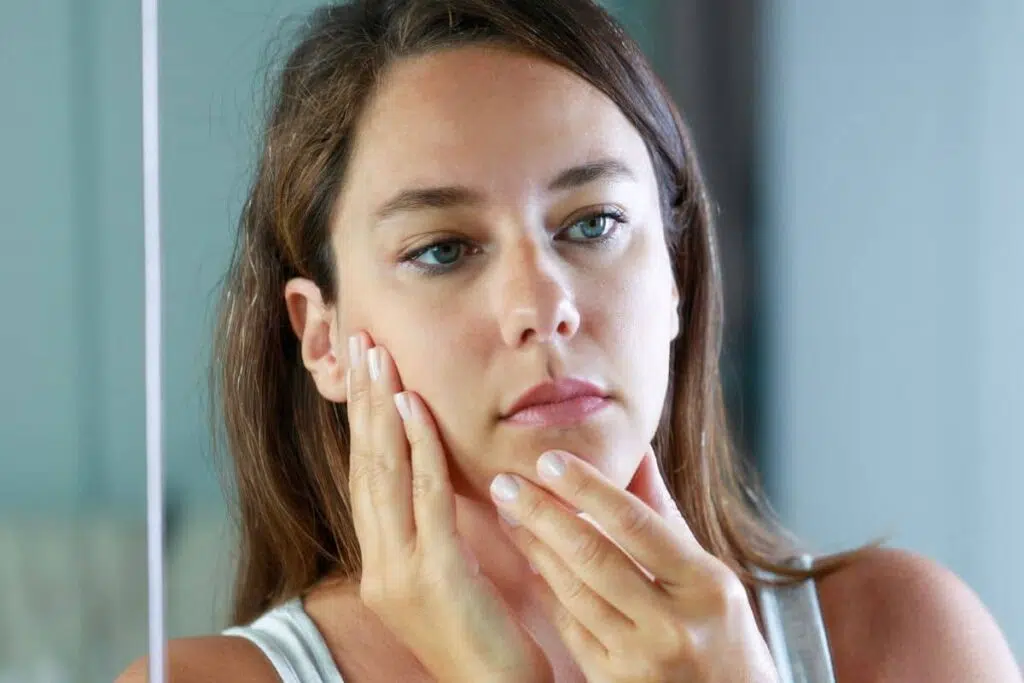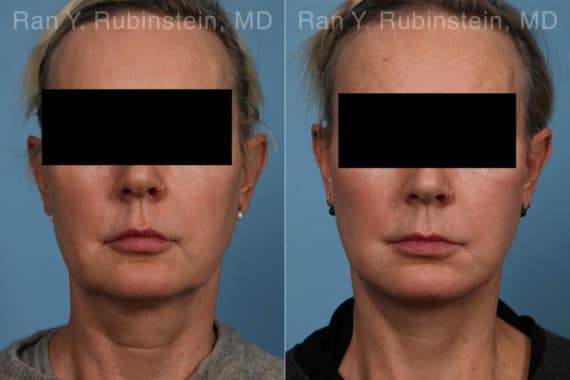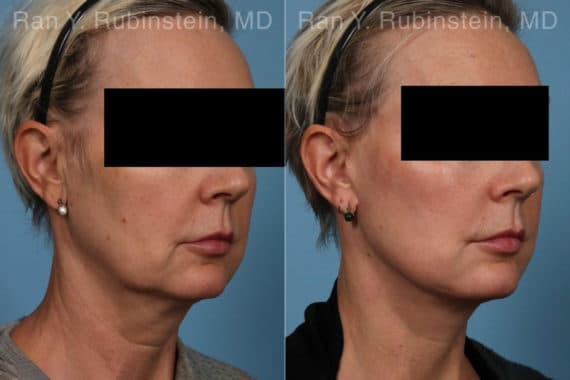Losing weight—especially rapidly or through medications like Ozempic—can feel like a major win for your health. But for many people, dramatic weight loss also brings some unexpected changes to their face. You might notice new hollowness in your cheeks, loose skin around your jawline, or deeper wrinkles that weren’t there before. These changes can make you look older than you feel, even if your body is healthier and you’ve achieved important weight loss goals.
If you’re wondering whether facelift vs fillers are the right choice to refresh your appearance after weight loss, you’re not alone. Both options offer effective ways to restore facial volume and improve skin tone. But knowing the best approach depends on your goals, skin quality, and how much correction you need. This guide compares facelifts and fillers to help you understand which treatment may be best after weight loss.

What You Need to Know Before Choosing: Quick Facts
- Weight loss can cause sagging skin, hollowness, and loss of facial volume.
- Fillers are ideal for mild to moderate volume loss with no downtime.
- Facelift surgery offers long-lasting, more dramatic results.
- Deep plane facelift techniques provide the most natural-looking rejuvenation.
- A consultation with Dr. Rubinstein can help you choose the right path.
Effects of Weight Loss on Facial Appearance
When you lose weight, your face is often the first place it shows. The fat that once added youthful contour to your cheeks, temples, and jawline may shrink or disappear entirely. While that can be great for your overall health and body goals, it’s not always flattering for your face. Without that supportive volume, the result can be a gaunt, tired, or prematurely aged appearance—especially if your skin doesn’t bounce back as easily as it used to.
Common areas affected by weight loss include the cheeks, jawline, neck, under-eye area, and temples. The cheeks can appear flat or sunken, while sagging skin and jowls may develop along the jawline. The neck often shows laxity or a crepey texture, and hollows or shadows can become more pronounced beneath the eyes and at the sides of the forehead.
Impact on Facial Volume
Facial fat plays a key role in keeping your face looking youthful and balanced. When you lose that fat—especially in the midface—it can cause your skin to collapse inward, creating deeper folds and sharper angles. This “ozempic face” phenomenon isn’t exclusive to injectable weight loss medications; it happens with any significant weight loss.
Dermal fillers can restore some of this lost volume, especially in:
- The cheeks and midface
- Nasolabial folds
- Marionette lines
- Temples and under-eye area
However, if skin laxity is also present, fillers may not be enough on their own.
Changes in Facial Skin Elasticity

Skin stretches with weight gain, and it doesn’t always shrink back with weight loss—especially as we age. If your skin has diminished elasticity, it may not conform to your slimmer facial structure, leaving you with sagging around the cheeks, jawline, and neck.
This is where facelift procedures come in. While fillers can plump up certain areas, only a facelift or neck lift can remove excess skin and lift sagging tissue.
Increased Hollowness
In addition to sagging skin, many patients notice an overall hollow or “sunken” appearance after weight loss. This is often most noticeable in the cheeks, temples, and under-eye areas. Fat loss in these regions can make the face appear tired or even unhealthy.
Fillers offer an excellent, non-surgical option to fill in these hollows. However, when hollowness is paired with loose or drooping skin, a combination of facelift surgery and filler treatment may be required for comprehensive rejuvenation.
Facelift vs Fillers after Weight Loss
Deciding between a facelift and dermal fillers after weight loss comes down to a few key factors: how much volume you’ve lost, the condition of your skin, and what kind of results you’re looking for. Both treatments are highly effective and have high patient satisfaction—but they work in fundamentally different ways.
Facelift surgery delivers more dramatic, longer-lasting results—often 10 years or more—by lifting and tightening deeper facial tissues. As a form of plastic surgery, a facelift offers structural rejuvenation that goes beyond the surface. According to the American Society of Plastic Surgeons, facelifts have a success rate of over 90%. Dermal fillers, by contrast, are non-surgical and offer immediate results, but they’re temporary, typically lasting 6 to 24 months depending on the product and treatment area.
What Each Procedure Involves
After weight loss, many patients consider either facelift surgery or dermal fillers to restore a youthful facial appearance. While both options can address common concerns like sagging and volume loss, the methods are very different.
faCELIFT
Facelift is a surgical procedure that lifts and tightens the deeper tissues of the face. Dr. Rubinstein specializes in the deep plane facelift, an advanced technique that lifts the underlying muscle and fat layers together for a more natural and longer-lasting result. This method avoids the tight or pulled appearance sometimes associated with older facelift techniques.
Dermal fillers
Dermal fillers, on the other hand, are injectable treatments that use hyaluronic acid-based products like Juvederm or Restylane to restore lost volume and smooth wrinkles. They’re ideal for patients who want a non-surgical solution to facial aging, particularly in the cheeks, under-eyes, and around the mouth.
What They’re Best at Fixing
Facelift surgery
It is best for:
- Sagging skin around the cheeks, jawline, and neck
- Jowls and deep folds
- Muscle laxity in the lower face
- Excess skin that doesn’t improve with fillers
Dermal fillers
They are best for:
- Hollow cheeks or temples
- Tear troughs and under-eye circles
- Nasolabial folds and marionette lines
- Mild to moderate volume loss without sagging skin
If you’re dealing with both skin laxity and volume loss, Dr. Rubinstein may recommend a combination approach, blending facelift surgery with strategic filler treatment for the most natural, balanced results.
Not sure which treatment fits your needs?
Dr. Rubinstein’s expert consultation can help you make the right choice. Schedule a consultation to get a customized plan.
Techniques and Treatment Options
There are several different types of facelift procedures available today, each designed to address specific concerns and aging patterns. While they all share the goal of facial rejuvenation, the techniques differ in how they reposition tissue, remove excess skin, and deliver results.
Deep Plane Facelift
The deep plane facelift is considered the gold standard for patients seeking natural-looking, long-lasting results. This advanced technique lifts the deeper layers of facial tissue—specifically the SMAS (superficial musculoaponeurotic system) and associated fat pads—rather than simply tightening the skin. By releasing and repositioning these underlying structures, the deep plane facelift rejuvenates the midface, jawline, and neck in a way that appears soft, smooth, and never overdone.
Dr. Rubinstein specializes in the deep plane facelift and often recommends it for patients with moderate to advanced signs of aging, particularly after weight loss. Compared to other techniques, it offers more comprehensive correction, longer-lasting results (often 10–15 years), and a quicker return to natural facial movement and expression.
Deep Plane Facelift Patient Results
* All patients are unique and individual results may vary.
Traditional Facelift
The traditional facelift, sometimes called the SMAS facelift, targets moderate to significant sagging in the lower face and neck. It involves lifting both the skin and underlying muscle layer, and often includes the removal of excess skin and fat. This method can dramatically improve jowls, marionette lines, and neck laxity.
While effective, the traditional facelift has evolved over time, and many surgeons—including Dr. Rubinstein—now favor the deep plane technique for its superior longevity and natural results. However, the traditional approach may still be appropriate for some patients depending on their anatomy and goals.
Filler Options
At Dr. Rubinstein’s practice, injectable treatments are fully customized. Available options include:
- Juvederm Voluma: Adds structure and lift to the temples, cheeks and midface, helping smooth out deep wrinkles in the process
- Juvederm Volux: Add structure to the chin and jawline, reducing the appearance of jowling
- Restylane Eyelight: Softens under-eye hollows
- Restylane Contour: Adds volume and subtle lift to the cheeks and midface
- Fat Transfer: Uses your own fat to restore volume naturally
These filler options are often used to address specific concerns or maintain results after surgery.
Longevity of Results
If longevity is your top priority, a facelift offers the most durable outcome.
- Facelift results can last 10–15 years, especially with deep plane techniques.
- Dermal filler results vary by product and placement, generally lasting 6–24 months, but subtle improvements can often be maintained with routine touch-ups.
Many patients start with fillers to address early signs of facial aging and later choose facelift surgery as aging progresses or skin laxity increases.
Downtime and Recovery: What to Expect
Facelift Recovery
Facelift surgery involves more downtime, but the results are much more transformative. Most patients need 14 days off from work or public activities. Swelling, bruising, and tightness are normal in the first two weeks and continue to improve over time. You can resume light activities within two weeks, but full healing may take several months.
Filler Recovery
Dermal fillers require little to no recovery. Most patients experience minor swelling or bruising, which fades within a few days. You can return to work and social activities the same day, making fillers a convenient option for patients with busy schedules who want to avoid a lengthy recovery process.
Risks and Considerations
Every procedure comes with potential risks, though serious complications are rare—especially when performed by a qualified plastic surgeon.
Facelift risks
It may include:
- Bruising and swelling
- Temporary numbness
- Infection or scarring
- Nerve injury (rare)
- Hematoma (collection of blood under the skin)
Filler risks
They may include:
- Swelling, bruising, or tenderness
- Lumps or asymmetry
- Allergic reactions (rare)
- Vascular occlusion (blocked blood vessel), which requires immediate treatment
Choosing a highly skilled provider like Dr. Rubinstein greatly reduces the risk of complications and ensures your safety throughout the treatment process.
Considerations for Choosing Between Facelift Surgery and Dermal Fillers
When deciding between a facelift and fillers after weight loss, the right option depends on a few key factors:
- Skin elasticity: If your skin still has good elasticity, fillers can restore volume effectively. But if skin sagging is more advanced, a facelift may be the better solution.
- Severity of volume loss: Mild to moderate hollowing often responds well to dermal fillers. More dramatic changes—especially combined with loose skin—usually call for a facelift or a combined approach.
- Downtime and goals: Fillers are ideal for those who want quick results with little to no recovery time. A facelift requires more healing time but delivers longer-lasting, more comprehensive rejuvenation.
- Budget and longevity: While fillers are less expensive initially, maintenance treatments add up. A facelift offers a one-time investment with results that can last 10 to 15 years.
For many patients, the most natural and lasting results come from combining both treatments—using surgery to reposition and tighten the skin, and fillers to refine or restore lost volume in key areas like the cheeks, lips, or tear troughs.
A personal consultation with Dr. Rubinstein is the best way to determine the right treatment plan for your face, your lifestyle, and your long-term goals. He will walk you through the expected benefits of each approach so you can feel confident in your choice.
Why Choose Dr. Ran Rubinstein?
Dr. Ran Rubinstein is a double board-certified facial plastic surgeon with over two decades of experience in facelift procedures and aesthetic treatments. His advanced use of deep plane facelift techniques, combined with expert-level injectable treatments, allows him to create natural, balanced results that never look “done.”
His plastic surgery practice in New York offers a patient-centered approach, combining artistry, safety, and the most advanced methods available. If you’ve experienced facial changes after weight loss and are considering your next step, Dr. Rubinstein is here to guide you toward the treatment that suits your goals.
Schedule your consultation today to restore your confidence and love what you see in the mirror.



